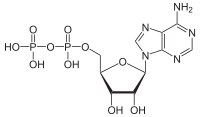
Back حلمأة الـATP Arabic ATP-hidroliza BS Hidrólisis de ATP Spanish Hidrólise do ATP Galician ATP 가수분해 Korean Quá trình thủy phân ATP Vietnamese
This article needs additional citations for verification. (February 2015) |



ATP hydrolysis is the catabolic reaction process by which chemical energy that has been stored in the high-energy phosphoanhydride bonds in adenosine triphosphate (ATP) is released after splitting these bonds, for example in muscles, by producing work in the form of mechanical energy. The product is adenosine diphosphate (ADP) and an inorganic phosphate (Pi). ADP can be further hydrolyzed to give energy, adenosine monophosphate (AMP), and another inorganic phosphate (Pi).[1] ATP hydrolysis is the final link between the energy derived from food or sunlight and useful work such as muscle contraction, the establishment of electrochemical gradients across membranes, and biosynthetic processes necessary to maintain life.
Anhydridic bonds are often labelled as "high-energy bonds". P-O bonds are in fact fairly strong (~30 kJ/mol stronger than C-N bonds)[2][3] and themselves not particularly easy to break. As noted below, energy is released by the hydrolysis of ATP. However, when the P-O bonds are broken, input of energy is required. It is the formation of new bonds and lower-energy inorganic phosphate with a release of a larger amount of energy that lowers the total energy of the system and makes it more stable.[1]
Hydrolysis of the phosphate groups in ATP is especially exergonic, because the resulting inorganic phosphate molecular ion is greatly stabilized by multiple resonance structures, making the products (ADP and Pi) lower in energy than the reactant (ATP). The high negative charge density associated with the three adjacent phosphate units of ATP also destabilizes the molecule, making it higher in energy. Hydrolysis relieves some of these electrostatic repulsions, liberating useful energy in the process by causing conformational changes in enzyme structure.
In humans, approximately 60 percent of the energy released from the hydrolysis of ATP produces metabolic heat rather than fuel the actual reactions taking place.[4] Due to the acid-base properties of ATP, ADP, and inorganic phosphate, the hydrolysis of ATP has the effect of lowering the pH of the reaction medium. Under certain conditions, high levels of ATP hydrolysis can contribute to lactic acidosis.
- ^ a b Lodish, Harvey (2013). Molecular cell biology (7th ed.). New York: W.H. Freeman and Co. pp. 52, 53. ISBN 9781464109812. OCLC 171110915.
- ^ Darwent, B. deB. (1970). "Bond Dissociation Energies in Simple Molecules", Nat. Stand. Ref. Data Ser., Nat. Bur. Stand. (U.S.) 31, 52 pages.
- ^ "Common Bond Energies (D". www.wiredchemist.com. Retrieved 2020-04-04.
- ^ Berne & Levy physiology. Berne, Robert M., 1918-2001., Koeppen, Bruce M., Stanton, Bruce A. (6th, updated ed.). Philadelphia, PA: Mosby/Elsevier. 2010. ISBN 9780323073622. OCLC 435728438.
{{cite book}}: CS1 maint: others (link)
© MMXXIII Rich X Search. We shall prevail. All rights reserved. Rich X Search